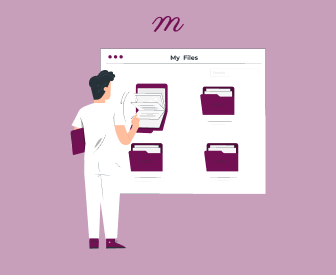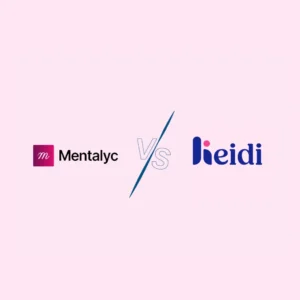The Electronic health record history reflects a major shift in how client information is documented, stored, and accessed in healthcare and mental health settings. Long before digital systems, records were kept entirely on paper, vulnerable to damage, loss, or theft, and often difficult to organize or retrieve. Early versions of EHRs focused primarily on billing and offered minimal support for clinical work.
Over time, advancements in technology transformed EHRs into essential tools that not only streamline administrative tasks but also enhance the quality and coordination of care.
Over the past 25 years, EHRs have grown from simple tools into powerful systems for healthcare. They now help improve diagnoses, track health outcomes, and make client data easier to manage. This change has also made it possible to use health records for large-scale research and better clinical decision-making. The move from paper to digital has transformed healthcare into a more accurate, secure, and efficient system.
What are Electronic Health Records?
Electronic health record is a digital archive of a client’s medical history written by their healthcare providers. They contain information like client demographics, medical/psychological history, progress notes, or medication history. EHRs’ designs are for easy storage, retrieval, sharing, and analyzing of client information. EHRs can be hosted on cloud-based servers or remote servers.
A vast array of healthcare-related tasks can be supported by EHRs. These consist of evidence-based decision support, outcome reporting, and quality assurance. EHRs are thus not only expected to store data, but to improve the quality and efficiency of healthcare services.
Electronic Health Record History
The Paper Chart Era: (Pre-Digital Healthcare Documentation)
The history of mental healthcare documentation dates back several millennia. The earlier forms of record-keeping can be traced back to ancient civilizations. For example, the Sumerian clay tablets (2400 BCE) contained lists of prescriptions. The Egyptian Ebers Papyrus (circa 1550 BCE) contained medical recommendations for different conditions. Hippocrates (460-370 BCE) from Ancient Greece codified treatments and kept detailed case notes.
In the 18th century, German physician Johann Theodor Eller introduced ‘daily patient observations’. He made doctors at Berlin’s Charité hospital document clients’ illnesses and treatment histories. The rise of social health insurance necessitated the need for standardized medical records. This pioneered the use of digital files to track clients’ care and address legal issues.
The Birth of Early EHR Systems (1960s – 1980s)
The earliest attempts at computer-based medical records arose in the 1960s. Data storage was done via punch cards, however, they were expensive and not very useful. Dr. Larry Weed then established the Problem-Oriented Medical Record (POMR) in 1968. This led to a shift in focus from traditional to a structured EHR system.
These early EHR systems were referred to as clinical health information systems. One of such systems was built by Martin Lockheed in the mid-1960s. At the time, pioneering institutions began to adopt EHR. The Mayo Clinic was also one of the organizations that adopted EHRs in the 1960s.
The Veterans Administration (VA) developed its own EHR system around 1972. This was known as VistA (Veterans Health Information Systems and Technology Architecture). The Institute of Medicine (IOM) was also a major force in promoting the adoption of EHRs in the 1980s.
1990s – 2000s (EHRs Enter Mainstream Healthcare)
This era was characterized by the increased affordability and prevalence of the internet. The first digital EHRs that enabled faster access to health information were developed. 1996 saw the formation of the Health Insurance Portability and Accountability Act (HIPAA). Its objectives were to standardize EHR transactions and guarantee privacy and security.
In 2004, The Office of the National Coordinator for Health Information Technology (ONC) was founded. Former President George W. Bush championed this campaign, which led to the widespread adoption of EHRs. About 34.8% of doctors who worked in offices had EHRs by 2007. By 2017, this percentage had increased to almost 85.9 percent.
HITECH Act and the Push for Nationwide Adoption (2009)
The year 2009 saw the enactment of the Health Information Technology for Economic and Clinical Health (HITECH) Act. One of the main components of the American Recovery and Reinvestment Act was HITECH. The allocation of billions of dollars was done to encourage the use of EHRs across the United States.
The “Meaningful Use” initiative was also introduced under the HITECH Act. It provided financial rewards for healthcare professionals and hospitals with certified EHR technology. The Act also extended HIPAA to business associates. This made them directly accountable for HIPAA compliance and introduced penalties for violations.
Modern EHR Systems: Features, Benefits, and Limitations
Features of Modern EHR Systems
EHR systems now have a wide range of features intended to boost clinical treatment and assist mental health practitioners. These features include: Interoperability, adaptable note templates, and an intuitive user interface. It also had other features such as easy billing systems and integration with telehealth platforms. EHR systems provide a client’s portal, order management, and decision support systems.
Benefits of Modern EHR Systems
The advanced features of Modern EHR Systems present several benefits for various healthcare stakeholders.
- For clients- EHRs can translate to better quality of care.
- For healthcare professionals- It permits the easy retrieval of client health information.
- For organizations/institutions- EHRs ensure cost savings through less paperwork and fewer clinical errors.
Limitations of Modern EHR Systems
Despite these advantages, modern EHR systems still face some challenges. These include initial and maintenance expenses, security and privacy risks, and technological issues. EHR systems can also affect workflow as healthcare professionals learn to adjust. Alert fatigue may also occur due to a series of alerts and notifications.
Impact of EHRs on Client Care and Provider Workflows
Impact of EHRs on Client Care
The safety and quality of client care have been impacted by the integration of EHRs. A client’s whole medical history can be accessed quickly and easily with EHRs. These could include previous medical diagnoses, assessments, prescription drugs, or allergies. Through client portals, EHRs enable clients to participate in their own healthcare.
It also provides secure messaging features that allow clients and healthcare professionals to interact. The client-provider relationship is strengthened by the ability for clients to ask questions and get prompt answers. Telemonitoring and virtual consultations are also made possible by EHRs. Clients with mobility issues or those who live in rural places may find this useful.
Impact of EHRs on Provider Workflows
EHR systems have had both advantages and disadvantages for mental healthcare practitioners. In terms of efficiency, EHRs can simplify a number of administrative duties. These activities increase productivity and include prescription refills, billing procedures, and appointment scheduling. Diagnosis and actions have been accelerated by EHR’s real-time access to client data. Wait times have decreased and client inflow has improved as a result.
However, some mental healthcare providers have been impacted by the shift to EHRs and are finding it difficult to adjust. Poorly designed or complex EHR interfaces can make tasks more difficult to complete. This can occasionally lead to a brief drop in productivity and an increase in workload. The amount of time required for data entry and documentation can be quite substantial for mental health professionals with larger caseloads. EHRs require alertness and focus which can cause cognitive fatigue overtime. The time used in working with the EHRs are most times unaccounted for and undervalued. This could lead to extension of the planned client hours and a rise in stress or burnout.
The Future of EHRs: Interoperability, AI, and Patient Access
Interoperability and the Future of EHRs
The future of the EHR system is enhancing the interoperability of health systems and services. Direct client information transfer across healthcare providers is ensured by interoperability. HL7 FHIR (Fast Healthcare Interoperability Resources) is helping to facilitate these efforts. This project establishes guidelines for the sharing of medical data.
Interoperability is being promoted by legislative initiatives, like the 21st Century Cures Act. These programs use EHR systems to share information with ease. These initiatives mandate EHR systems to exchange data without incurring information-blocking barriers. It is expected that cloud-based EHRs will enhance interoperability. This is because they streamline access to shared resources across the mental healthcare sector.
Artificial Intelligence (AI) Integration in EHR Systems
AI is set to change the functionality and impact of EHR systems in the years to come. With the use of AI, future EHRs will be useful for detecting patterns and making health predictions. These will provide mental health professionals with sophisticated assistance in diagnosis and treatment. AI tools are also expected to continue automating time-consuming tasks such as documentation. For instance, Mentalyc is an AI-powered documentation tool for mental health practitioners. It is developed to make writing of intake and progress notes faster and easier.
It is anticipated that integrating AI into EHR systems will enhance data analysis as well. Mental health practitioners will be able to learn more about client data as a result. Predictive analysis and treatment planning will be more successful with improved data analysis.
The Future of EHRs: Enhanced Client Access
The future of EHRs is making it easy for clients to access their health records. This will enable them to take a more active role in managing their health. Client portals that are intuitive and interactive, and mobile apps are being developed. With this technology, clients will be able to access their diagnosis, treatment plans, and assessment results.
Will AI Replace Traditional EHR Systems?
The integration of AI into EHR systems has prompted concerns about its replacement with traditional ones. AI has been able to buffer the many limitations of traditional EHRs. However, there are several issues in integrating AI into healthcare systems. Among these challenges are the concerns about data privacy and security.
There is also the potential bias of AI algorithms to consider. Even though AI has the potential to change EHR systems, these issues must be resolved. It is important to note that AI will develop modern EHR systems but not entirely replace them. It becomes imperative to take AI’s ethical and regulatory implications into account.
Challenges of using EHRs
Two major issues with EHR systems are their ease of use and the strain they place on clinicians. Stress and cognitive strain could result from the massive amount of data to be reviewed or ill-designed EHR interfaces. EHR tool acquisition and installation can be costly, especially for small practices. The preference of certain professionals for conventional paper-based techniques presents yet another difficulty.
Conclusion
Both legislative achievements and technology improvements have shaped the history of EHRs. EHRs have shown to be very helpful for clients and mental healthcare professionals. With the incorporation of AI, the future of EHRs appears bright.
Making sure the EHR tools has a user-centered design can help mental health practices overcome the difficulties they face. Comprehensive training options could be provided to lessen the effort for providers. Additionally, providers might investigate less expensive options like cloud-based solutions. The benefits of EHRs should also be highlighted in order to overcome resistance to their adoption.
Frequently Asked Questions
What Was The Main Drive For Adopting EHRs In Mental Health?
The main drive for adopting EHRs in mental health was to provide clients with better care. EHRs made the sharing of important information between healthcare professionals simple. This teamwork helped make treatments much more effective for clients. It also helped clinics run smoother, with lesser cost implications.
How Does HIPAA Specifically Affect EHRs In Mental Health?
HIPAA is an important aspect of EHRs. It focuses on the privacy and confidentiality of client data. It ensures that there are strict rules for protecting sensitive patient data. Strong security measures are essential for all digital records. For instance, HIPAA gives an extra layer of protection to therapy notes.
Which EHR Tools Are Available For Mental Health Professionals?
There are quite a variety of EHR tools out there now. However, some EHR systems are designed specifically for mental health needs. These often include features for therapy notes, treatment plans, and even billing. Mentalyc is one such tool that allows for easy note-taking in mental health practice.
References
Amatayakul, M. (2009). Electronic health records: A practical guide for professionals and organizations. ResearchGate. https://www.researchgate.net/publication/265230056_Electronic_Health_Records_A_Practical_Guide_for_Professionals_and_Organizations
CDLI contributors. (2025, May 20). CDLI tablet: Beer: Medicinal use. Cuneiform Digital Library Initiative. https://cdli.earth/cdli-tablet/553
Edemekong, P. F., Annamaraju, P., Afzal, M., & Haydel, M. J. (2024, November 24). Health Insurance Portability and Accountability Act (HIPAA) compliance. StatPearls. https://www.ncbi.nlm.nih.gov/books/NBK500019/
Encyclopaedia Britannica. (n.d.). Ebers papyrus. https://www.britannica.com/topic/Ebers-papyrus
HealthIT.gov. (n.d.). 20 years of health IT. https://www.healthit.gov/20years/
HIPAA Journal. (n.d.). What is the HITECH Act?. https://www.hipaajournal.com/what-is-the-hitech-act/
Jha, A. K., DesRoches, C. M., Campbell, E. G., Donelan, K., Rao, S. R., Ferris, T. G., Shields, A., Rosenbaum, S., & Blumenthal, D. (2009). Use of electronic health records in U.S. hospitals. New England Journal of Medicine, 360(16), 1628–1638. https://pubmed.ncbi.nlm.nih.gov/19321858/
Kaplan, F., & di Lenardo, I. (2017). Big data of the past. Frontiers in Digital Humanities, 4, Article 12. https://doi.org/10.3389/fdigh.2017.00012
Makam, A. N., & Nguyen, O. K. (2014). An evidence-based medicine approach to electronic health records. Journal of General Internal Medicine, 29(1), 6–7. https://pmc.ncbi.nlm.nih.gov/articles/PMC4215056/
Miller, R. H., & Sim, I. (2004). Physicians’ use of electronic medical records: Barriers and solutions. Health Affairs, 23(2), 116–126. https://pmc.ncbi.nlm.nih.gov/articles/PMC11526839/
Mitchell, J. (2017, June 21). History of electronic health records. Study.com. https://study.com/academy/lesson/history-of-electronic-health-records.html
Moxey, A., Robertson, J., Newby, D., Hains, I., Williamson, M., & Pearson, S.-A. (2010). Computerized clinical decision support for prescribing: Provision does not guarantee uptake. Journal of the American Medical Informatics Association, 17(1), 25–33. https://pmc.ncbi.nlm.nih.gov/articles/PMC9599146/
Rao, S. K., DesRoches, C. M., Donelan, K., Campbell, E. G., Miralles, P. D., & Jha, A. K. (2008). Electronic health records in small physician practices: Availability, use, and perceived benefits. Journal of the American Medical Informatics Association, 15(6), 513–519. https://www.researchgate.net/publication/5364768_Adoption_and_Perceptions_of_Electronic_Health_Record_Systems_by_Ophthalmologists_An_American_Academy_of_Ophthalmology_Survey
Shen, Y., Yu, J., Zhou, J., & Hu, G. (2025). Twenty-five years of evolution and hurdles in electronic health records and interoperability in medical research: Comprehensive review. Journal of Medical Internet Research, 27, e59024. https://doi.org/10.2196/59024
Why other mental health professionals love Mentalyc

“If I were recommending this software to a colleague, I would tell them that it is the best thing that they could do for their practice.”
Licensed Professional Counselor

“For those who have hesitations … It is a lifesaver. It will change your life and you have more time to be present with your patients.”
Licensed Clinical Social Worker

“Do yourself a favor, make your life easier. Use the tools that are readily available … I found Mentalyc to be one of the best tools that I’ve ever used.”
Licensed Marriage and Family Therapist

“It immediately changed my quality of life, personally and professionally. I went from 3–4 hours a week of notes to 1 hour at most … that alone is invaluable personally and professionally.”
Owner/Independently Licensed Marriage & Family Therapist (IMFT)






